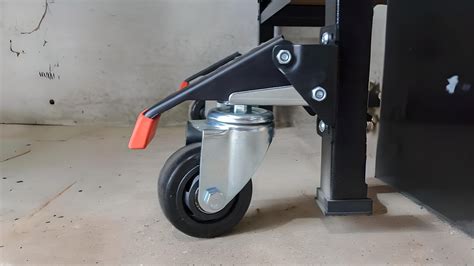Castors: The Essential Guide to Enhancing Mobility
Castors, those ubiquitous yet often overlooked wheels that reside beneath countless objects in our homes, offices, and industries, play a crucial role in facilitating movement and enhancing efficiency. This comprehensive guide delves into the world of castors, unraveling their types, applications, and the intricate factors to consider when selecting the perfect castors for your specific needs.
Types of Castors
Castors come in a bewildering array of types, each tailored to specific applications and environments. Here are the most prevalent types:
1. Swivel Castors: These highly versatile castors can rotate 360 degrees, providing unmatched maneuverability for equipment, furniture, and more. They shine in applications where effortless direction changes are paramount.

2. Rigid Castors: Unlike their swiveling counterparts, rigid castors are fixed in a single direction. Their primary function is to bear weight and provide stability, making them ideal for heavy-duty applications like industrial equipment.

3. Single-Wheeled Castors: These simple yet effective castors comprise a single wheel attached to a plate or bracket. They excel in space-constrained environments and are commonly found on lightweight equipment.
4. Twin-Wheeled Castors: Boasting two wheels side-by-side, twin-wheeled castors offer enhanced stability and load capacity compared to their single-wheeled counterparts. They are often employed on larger pieces of equipment and furniture.
5. Double-Ball Bearing Castors: Incorporating two rows of ball bearings, these castors ensure smooth and effortless rolling under heavy loads. They are ideal for applications demanding exceptional durability and load-bearing capacity.
Materials Used in Castors
The choice of materials used in castor construction has a significant impact on performance, durability, and suitability for different applications. Here are the most commonly used materials:

1. Iron: Durable and robust, iron castors withstand heavy loads and rough conditions. They are often found in industrial settings and heavy-duty equipment.

2. Steel: Boasting superior strength-to-weight ratio, steel castors offer exceptional load capacity and durability. They are suitable for heavy-duty applications and demanding environments.
3. Nylon: Lightweight and non-marking, nylon castors are resistant to corrosion and chemicals, making them suitable for clean environments like hospitals and laboratories.
4. Polyurethane: Renowned for its resilience and durability, polyurethane is used to create castors that provide a smooth and quiet ride even on rough surfaces.
5. Rubber: Offering excellent shock absorption and vibration dampening properties, rubber castors are ideal for applications where quiet operation and protection of sensitive equipment is essential.
Selecting the Right Castors
When selecting castors for your specific application, it is essential to consider several key factors:
1. Load Capacity: Determine the maximum weight the castors will bear to ensure they can safely support the intended load.
2. Wheel Diameter: Larger wheel diameters provide better stability and maneuverability, while smaller diameters are suitable for confined spaces.
3. Floor Type: Consider the surface type the castors will roll on, such as wood, concrete, or carpeting, to select wheels with appropriate treads.
4. Operating Environment: Factors like temperature, humidity, and potential chemical exposure should be considered to ensure the castors are suited to the environment.
5. Intended Use: Different applications have specific requirements. For example, hospital equipment requires quiet and non-marking castors, while industrial machinery demands durability and load capacity.
Tips and Tricks
To ensure your castors provide optimal performance and longevity, follow these useful tips:
-
Lubricate regularly: Apply grease or oil to the castor bearings periodically to reduce friction and extend their lifespan.
-
Inspect regularly: Periodically check for worn or damaged wheels, bearings, or brackets to ensure timely repairs or replacements.
-
Choose the right type: Select castors specifically designed for your application and intended use.
-
Use levelers: If necessary, use leveling feet or pads to adjust the height of the equipment and prevent uneven distribution of weight.
-
Avoid overloading: Exceeding the load capacity of the castors can lead to damage and safety hazards.
Common Mistakes to Avoid
Steer clear of these common pitfalls when selecting and using castors:
-
Ignoring load capacity: Overloading castors can cause premature failure and safety issues.
-
Choosing the wrong material: Selecting castors made from materials not suited to the operating environment can compromise performance and durability.
-
Neglecting maintenance: Inadequate lubrication and inspection can lead to premature wear and tear.
-
Using castors on unsuitable surfaces: Rolling castors on surfaces for which they are not intended can damage both the castors and the floor.
-
Mixing castor types: Combining different castor types on the same equipment can create instability and uneven load distribution.
**Table 1: Castor Wheel Diameters and Applications**
| Wheel Diameter (inches) |
Applications |
| 1-2 |
Furniture, carts, small equipment |
| 2-4 |
Office chairs, medical equipment, light industrial applications |
| 4-6 |
Heavy-duty equipment, industrial machinery |
| 6+ |
Forklifts, heavy machinery, construction equipment |
**Table 2: Castor Wheel Tread Materials**
| Material |
Properties |
Applications |
| Nylon |
Hard, non-marking, resistant to chemicals |
Clean environments, hospitals, laboratories |
| Polyurethane |
Resilient, durable, noise-reducing |
Industrial applications, rough surfaces |
| Rubber |
Shock-absorbing, vibration-dampening, quiet operation |
Hospitals, laboratories, delicate equipment |
| Cast iron |
Durable, heavy-duty, suitable for high loads |
Industrial settings, outdoor equipment |
**Table 3: Castor Types and Their Advantages**
| Castor Type |
Advantages |
| Swivel |
Maneuverability, effortless direction changes |
| Rigid |
Stability, weight-bearing capacity |
| Single-wheeled |
Space-saving, lightweight |
| Twin-wheeled |
Enhanced stability, load capacity |
| Double-ball bearing |
Durability, load-bearing capacity |
Conclusion
Castors may seem like humble components, but they play an indispensable role in enhancing mobility and efficiency in countless applications. By understanding the different types, materials, and factors involved in selecting the right castors, you can ensure that your equipment, furniture, and machinery move smoothly and safely, maximizing productivity and minimizing downtime.
